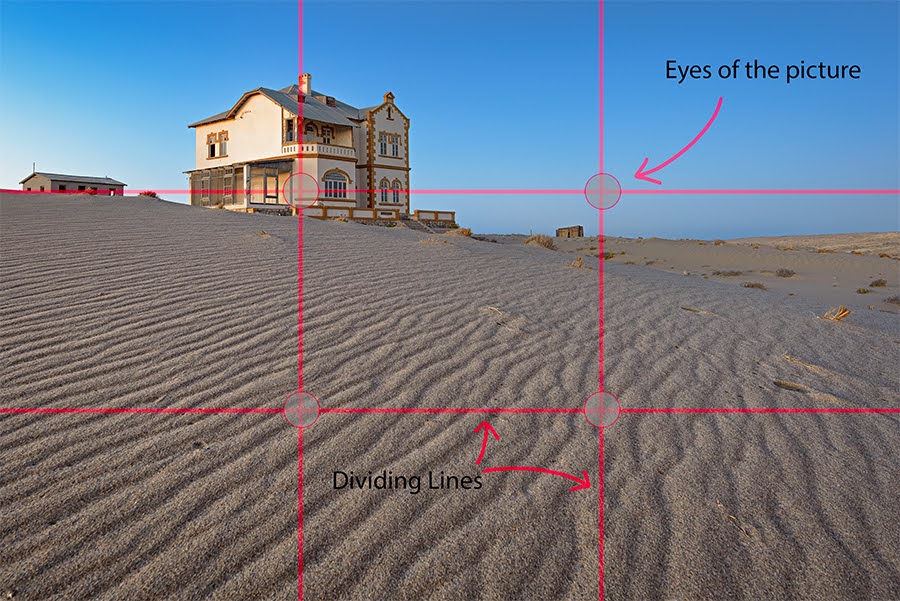The basic gist of the rule of thirds is that the image can be divided into 9 equally sized blocks by drawing 2 equidistant lines horizontally across the frame at third intervals (see image below), and an additional 2 vertically also at third intervals. The lines form a basic guide as to where to place the horizon (horizontal lines) and subject (vertical lines) so that there is an aesthetically pleasing arrangement that has a sense of harmony or balance. The engraver John Thomas Smith is possibly the first person to have written about this arrangement in his 1797 book, “Remarks on Rural Scenery” (his long explanation of this rule can be read on this wikipedia link). In more recent y§ears attention has been given to the actual intersection of the lines as forming what Niall Benvie calls, “the eyes of the picture” (Creative Landscape Photography 2001:32). The advice is still that the horizon should be placed on or near one of the horizontal lines, but that the subject or point of interest should be placed on one of the intersections of the lines.
 |
| An image of the managers house at Kolmanskop in Namibia showing the classic arrangement of the horizon and principle subject using the rule of thirds. |
The Golden Ratio was first written about by the ancient Greeks and was more than just a way of organizing the picture space. For the Greeks, perfection was found not in excesses, but rather in the space between two excesses. This idea of the middle path stretched into everything that the Ancient Greeks did; philosophy, governance, art, everything. For them beauty was a mixture of symmetry, proportion and harmony. The Golden Ratio is a mathematical principle expressed as: a+b is to a as a is to b (see this link for images) and was the mathematical expression of this ideal. Subsequently this principle has been mapped to a host of natural processes, although with varying success. Importantly the ratio is roughly 1.62 to 1, meaning that the perfect rectangle for the Ancient Greeks is 1.62 on the long side and 1 on the short. It is not the same as the 2:3 ration that we see through most APS and FF cameras and is also different to the many types of traditional and digital photographic papers that are available. Although I think it’s interesting that it is closer to the 16:9 aspect ration that is used for widescreen cinema (as a completely irrelevant aside I find myself veering towards the 16:9 aspect ratio for a lot of my own personal work, preferring it over the usual 2:3 aspect ratio of the camera). Above are the two principles with their counterparts overlapping. I personally disagree that the RoT is a dumbing down of the Golden Mean as the points are actually quite different.
 |
| My general preference tends toward the 16:9 aspect ratio which is closer to the ancient Greek's Golden Ration of 1.62 to 1. |
The basic premise of the Golden Ratio as a compositional guide, apart from the actual shape of the rectangle, is that a series of intersection points creates a spiral that gets smaller and smaller. It’s often suggested that the point where the spiral gets to its smallest is the point of tension within the composition. Think of it as the focal point for ease of illustration. The rest of the composition should be roughly guided by the spiral as it winds outwards. In this way a number of Henri-Cartier Bresson’s images have been illustrated to have used the Golden Ratio (see this post on Bresson’s cyclist image). Whether this was on purpose or not is unknown.
Putting the Golden Ratio aside for the moment, the way that the Rule of Thirds works on images is that it automatically creates a sense of balance within the frame. In a previous post I pointed out the importance of the picture frame itself. I would suggest that it is near impossible to view the image outside of the context of its frame. So, the frame can potentially dictate how the elements should be arranged in order to create the sense of balance. Imagine a bird flying against a blue sky. If we use the RoT to place the bird on one of the eyes of the picture we automatically create balance with the intersection diagonally opposite to the bird in question, even if there is nothing on that point. Automatically the image becomes more pleasing to the eye as the balance in the frame has also started to create a sense of story. A bird centred in the frame is simply a bird flying. A bird off to one-third of the frame is a bird that is moving in a direction. It isn’t simply hanging in space.
Think instead of a landscape. When the horizon is centred there is a definite feeling of flatness to the image. Theoretically, symmetry should give us balance, but, most landscapes have other elements either in the sky (clouds) or on the land. The elements in the sky are not necessarily balanced with those on the ground (reflections in water are a notable exception), so despite the horizon being centred the image becomes unbalanced. The RoT suggests placing emphasis on either the sky or the foreground by placing the horizon on or near one of the third lines. If the upper third line is chosen then the emphasis is on the foreground (and vice versa). Taking the RoT further, the suggestion is that the principle subject should be aligned with either the left or right vertical third. This again creates a form of balance that is pleasing to the eye within the context of the frame.
The important thing here is that the RoT works in the context of the image frame. I often perform a little exercise with groups where I bring up a 2/3 ratio rectangle frame with nothing in it. Asking one half of the group to watch the other half, I change the slide to one where there is a large black dot in the centre of this rectangular frame. The students watching the other students note that there is little to no eye-movement by the students watching the slides. I then put up a slide with the dot on one of the eyes of the picture (intersection of lines). Now the reporting students describe how the eye’s of the watching students flicker across the frame. Basically, what’s happening is that our eyes and brains are essentially lazy. When the subject is placed slap bang in the centre of the frame the brain needs to do the least amount of work to decipher the image. By placing the subject away from the centre of the frame the eye is forced to dart across to it. Interestingly, it’s as if our brains require some kind of balance, as straight after alighting on the subject, the eyes either flicker diagonally across to the opposite side of the frame (which is empty), or do a cyclical tour of the frame, seeking out other information, despite there being none.
 |
| The two slides that I show one after the other to gauge eye-movement of the viewer |
The RoT is not the same as the Golden Ratio, despite the suggestion that it is a lazy appropriation of it. For a start the rule of thirds works with any format choice, not just the rectangle. The Golden Ratio is more than a spiral, it’s about where the points of the spiral are, so drawing a spiral in a panoramic image is not the same as using the Golden Ratio. Yes, the RoT is easier to understand (thankfully) which is one of the reasons it is often the first tenet of composition that is mentioned. It is not the be-all and end-all of compositional theory though. Think of it more a compositional 'get out of jail free' card. It's there when you have absolutely no idea of how to compose the scene.
One of my favourite quotes is that of Henri-Cartier Bresson where he apparently said, “I hate rules, I love principles”. Rules tend to be adhered to religiously, while principles are guides that can be ignored if necessary. To me, the RoT is actually where the image potentially ends, rather than the starting point from which the composition is created. Ultimately the photographer should be aiming for content driven composition rather than rule driven composition. There is far more to composition than simply slapping the horizon on a line and the subject on a point in the frame. I hope to explore this a little more over the coming months with ways to recognize compositional elements and their ordering in the frame. Stay tuned for more.




No comments:
Post a Comment